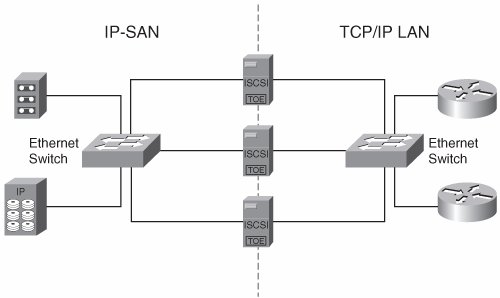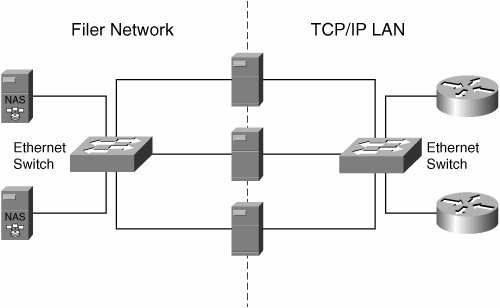What Is a Storage Network?
| You can define a storage network in various ways. One strict definition is any network designed specifically to transport only block-level storage protocols and their data. Fibre Channel SANs (FC-SANs) typify this strict definition. Though Fibre Channel can transport non-storage protocols, the vast majority of Fibre Channel SANs deployed today are designed specifically to transport SCSI traffic. Figure 1-1 illustrates a simple Fibre Channel SAN. Figure 1-1. Simple Fibre Channel SAN Common use of the phrase "storage area network" and the acronym "SAN" historically has referred to the Fibre Channel SAN model. However, these terms are somewhat ambiguous in light of recent developments such as the ratification of the Internet SCSI (iSCSI) protocol. The iSCSI protocol enables the use of the Transmission Control Protocol (TCP) on the Internet Protocol (IP) on Ethernet in place of Fibre Channel to transport SCSI traffic. An IP network dedicated to the transport of iSCSI traffic is commonly referred to as an IP-SAN. Note that any IP network can transport SCSI traffic; however, a multipurpose IP network that carries SCSI traffic is not called an IP-SAN. Likewise, the acronym FC-SAN is becoming common for the Fibre Channel SAN model. The unqualified term "SAN" is increasingly used to generically refer to both IP-SANs and FC-SANs. Figure 1-2 illustrates a simple IP-SAN. Figure 1-2. Simple IP-SAN The common definition of a file server is an off-the-shelf operating system (like UNIX or Windows) running on a multipurpose hardware platform (like a PC) configured to share files. By contrast, a network attached storage (NAS) filer typically runs a highly optimized (sometimes specialized) operating system on an optimized hardware platform specifically configured to share files. Another distinction is that UNIX and Windows file servers have native file-level protocols, whereas NAS filers do not. NAS filers are multiprotocol by design and typically support all mainstream file-level protocols. You can create a storage network by connecting NAS clients to NAS filers via a dedicated network. This model uses TCP/IP and Ethernet to transport file-level protocols such as the network file system (NFS) protocol, the common Internet file system (CIFS) protocol, the File Transfer Protocol (FTP) and the HyperText Transfer Protocol (HTTP). There is no common name for this model, but the phrases "filer network" and "file-sharing network" seem appropriate. The phrase "storage area network" is generally not used to describe this model. Figure 1-3 illustrates a simple filer network. Figure 1-3. Filer Network Note There have long been discussions of so-called Internet attached storage (IAS) devices characterized by the use of HTTP to retrieve files from and store files to the storage devices, which are directly attached to an IP network. No standards or other specifications have been produced to define how the operation of these devices would differ from the operation of a normal web server. Because most NAS filers support the use of HTTP for file-level access, IAS can be considered another name for NAS. One loose definition for a storage network is any network that transports any file-level or block-level storage protocol and associated data. Although valid, this definition is of little practical use because it essentially includes all the preceding definitions and every traditional computer network on the planet. For example, virtually every Windows-based network transports CIFS, which is the file-level storage protocol native to Microsoft operating systems. Likewise, virtually every UNIX-based network transports NFS, which is the file-level storage protocol native to UNIX operating systems. Even the Internet is included in this definition because the Internet transports FTP, HTTP, and various other protocols designed to transfer files. These points notwithstanding, it might be useful to have a name for traditional data networks that also transport block-level storage protocols. This is because special design considerations for timeslot and wavelength allocations, topology modifications, and quality of service (QoS) mechanisms might be required in addition to hardware and software upgrades for IP and optical networking devices and network management tools, to successfully integrate block-level storage protocols with traditional data and real-time data such as voice over IP (VoIP) and video conferencing. Such changes might be significant enough to warrant a distinction between traditional data networks and these new enhanced networks. A seemingly appropriate, albeit generic, name is storage-enabled network; however, the industry hasn't adopted this or any other name yet. |
EAN: 2147483647
Pages: 196


